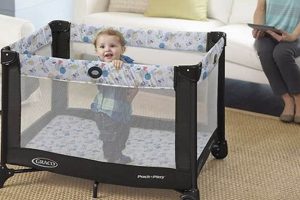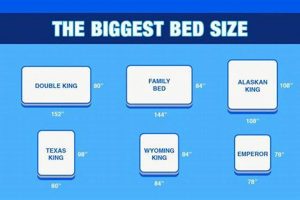Dimensions of sleeping surfaces in collegiate residential halls are typically longer and narrower than standard twin mattresses. These extended twin-sized surfaces, often referred to as “twin XL,” provide additional length to accommodate taller individuals common in the college-aged demographic. For example, while a standard twin is around 75 inches long, the extended version usually measures approximately 80 inches.
The implementation of these longer mattresses in dormitories addresses a specific need for student comfort, promoting better sleep quality. This, in turn, can positively impact academic performance and overall well-being during a crucial developmental period. Historically, standard twin mattresses were prevalent in dormitories, but the trend shifted towards extended lengths as universities recognized the increasing average height of incoming students.
Understanding these specifications is paramount when preparing for the collegiate living experience. Considerations include sheet and bedding compatibility, mattress topper selection, and optimal utilization of limited space within dormitory rooms. Further discussion will delve into selecting appropriate bedding, navigating purchasing options, and maximizing comfort within the confines of typical dorm room layouts.
Tips Regarding Dormitory Bedding Dimensions
Selecting appropriate bedding for a collegiate residential hall requires careful consideration. The following tips provide guidance for maximizing comfort and optimizing the sleeping environment within a limited space.
Tip 1: Confirm the Exact Dimensions. Prior to purchasing bedding, verify the precise dimensions of the designated dormitory mattress with the university’s housing department. Specifications may vary slightly between institutions.
Tip 2: Purchase Twin XL-Specific Bedding. Standard twin-sized sheets will not adequately fit an extended twin mattress. Ensure that all sheet sets, mattress protectors, and comforters are specifically labeled as “Twin XL.”
Tip 3: Consider a Mattress Topper. Dormitory mattresses are often basic in construction. A quality mattress topper, such as memory foam or down alternative, can significantly enhance comfort and support.
Tip 4: Invest in Durable Bedding. College life can be demanding. Select bedding materials that are both comfortable and resilient, capable of withstanding frequent washing and general wear and tear.
Tip 5: Prioritize Proper Sheet Fit. Fitted sheets with deep pockets are recommended to prevent slippage and ensure a secure fit, especially when using a mattress topper.
Tip 6: Mind the Headboard and Footboard. Some dormitory beds feature headboards and footboards that can interfere with bedding placement. Account for these features when determining the required length of comforters and bedspreads.
Tip 7: Evaluate Laundry Facilities. Consider the size and capacity of dormitory laundry machines when selecting bedding. Oversized comforters may require professional cleaning.
These tips highlight the importance of preparation and informed decision-making. Investing in appropriately sized and durable bedding contributes to a more comfortable and restful collegiate experience.
The following sections will address common challenges related to dorm room organization and further strategies for creating a personalized and functional living space.
1. Twin XL Designation
The “Twin XL Designation” is intrinsically linked to “college mattress size” due to its function as the de facto standard for sleeping surfaces in the vast majority of higher education residential facilities. This designation signifies a specific set of dimensions approximately 39 inches wide by 80 inches long that differentiate it from a standard twin mattress, which typically measures around 75 inches in length. The adoption of Twin XL mattresses in colleges stems from the need to accommodate the taller average height of the student demographic. Failing to provide adequate length can lead to discomfort, disrupted sleep, and potential negative impacts on academic performance.
The effect of the Twin XL designation is observed in the bedding industry, where manufacturers produce and market sheet sets, comforters, and mattress protectors specifically tailored to these dimensions. This specialized market underscores the practical significance of understanding this designation when preparing for college life. Students and parents must be aware that standard twin-sized bedding will not adequately fit a Twin XL mattress, leading to ill-fitting and uncomfortable sleep arrangements. For example, purchasing standard twin sheets for a Twin XL bed will result in sheets that cannot fully cover the mattress’s length, potentially causing them to detach during sleep and diminishing the overall sleeping experience.
In summary, the Twin XL designation is a crucial component of the “college mattress size” discussion. It serves as a standardized identifier that facilitates the selection of appropriate bedding and contributes to a more comfortable and restful collegiate living environment. The challenges associated with dormitory living, such as limited space, necessitate careful planning, and understanding this designation is a fundamental step in creating a functional and personalized living space. The proper selection of bedding tailored to the Twin XL designation is vital for optimizing sleep quality and overall student well-being during their academic pursuits.
2. Dimensions
The specification “Dimensions: 39 x 80 inches” directly defines the standard size of a significant portion of mattresses used in college and university residential halls. This measurement serves as a foundational element for students, parents, and housing providers in selecting appropriate bedding and planning the layout of dormitories.
- Standard Twin XL Specification
The “39 x 80 inches” dimension represents the Twin XL mattress size. It is the prevailing standard in collegiate housing due to its suitability for accommodating the average height of young adults. This standardization simplifies the process of sourcing bedding and ensures compatibility across institutions.
- Impact on Bedding Selection
The specific dimensions necessitate the purchase of Twin XL-sized sheets, comforters, and mattress protectors. Standard twin bedding, which is shorter, will not adequately cover the mattress, leading to discomfort and potential damage. The availability of bedding products tailored to these dimensions highlights the industry’s response to this specific need.
- Space Considerations in Dormitories
Dorm rooms are often compact, and the “39 x 80 inches” mattress size influences the overall spatial arrangement. Furniture selection and room layout must account for these dimensions to maximize functionality and comfort within the limited area. For instance, bed risers may be used to create additional storage space underneath, leveraging the vertical dimension.
- Influence on Sleep Quality
Adequate mattress length, as provided by the “39 x 80 inches” dimension, directly affects sleep quality. A mattress that is too short can lead to restless sleep and discomfort, potentially impacting academic performance. This dimension ensures sufficient support and comfort for the majority of students.
In summation, “Dimensions: 39 x 80 inches” is not merely a measurement but a key determinant in the collegiate living experience. Its influence extends from bedding selection and room arrangement to sleep quality and overall well-being, solidifying its importance in the context of “college mattress size.”
3. Sheet Compatibility
Sheet compatibility is inextricably linked to the “college mattress size,” specifically the Twin XL dimensions prevalent in dormitories. The effect of disregarding this connection manifests in ill-fitting bedding, leading to discomfort and disrupted sleep. The “college mattress size,” typically 39 inches by 80 inches, necessitates the use of Twin XL-sized sheets. Using standard twin sheets, which are shorter in length, results in inadequate coverage, causing the fitted sheet to slip off during the night and creating an uncomfortable sleeping surface. The importance of sheet compatibility stems from its direct influence on sleep quality, a factor demonstrably linked to academic performance and overall student well-being. For example, a student constantly adjusting ill-fitting sheets will experience fragmented sleep, which can negatively impact concentration and learning ability.
The market for Twin XL bedding exists precisely because of the unique dimensions of “college mattress size.” Retailers offer sheet sets specifically designed to accommodate the 80-inch length, ensuring a snug and secure fit. Furthermore, deep-pocketed sheets are often recommended to accommodate mattress toppers, which many students use to enhance the comfort of standard dormitory mattresses. Ignoring the specific requirements of “sheet compatibility” leads to practical challenges, requiring students to either purchase new bedding or endure uncomfortable and potentially disruptive sleep conditions. University housing departments often emphasize the importance of Twin XL sheets in pre-arrival information, highlighting the practical significance of this understanding.
In summary, sheet compatibility is a crucial component of the “college mattress size” consideration. Selecting appropriately sized bedding is not merely a matter of aesthetics but a critical factor in ensuring adequate sleep and maintaining a comfortable living environment. Failure to recognize and address this connection leads to preventable challenges that can negatively impact a student’s overall collegiate experience. The industry recognizes the need and provides several bedding options to purchase.
4. Space Optimization
In the context of “college mattress size,” space optimization refers to the strategic arrangement of limited living areas to maximize functionality and comfort. Due to the typically confined dimensions of dormitory rooms, effective space optimization becomes a necessity for collegiate residents.
- Vertical Space Utilization
The inherent footprint of the “college mattress size,” often a Twin XL, necessitates the exploitation of vertical space. Bed risers elevate the mattress, creating storage opportunities underneath for items such as storage bins, suitcases, or infrequently used supplies. Lofts are another example, elevating the entire bed frame to allow for a desk or seating area underneath. This approach alleviates floor clutter and maximizes the available workspace.
- Multi-functional Furniture
Due to the “college mattress size” occupying a considerable portion of the floor area, multi-functional furniture becomes essential. Examples include ottomans with built-in storage, foldable desks, and stackable containers. These items serve multiple purposes, minimizing the need for numerous individual pieces of furniture and conserving valuable floor space.
- Wall-Mounted Organization
Exploiting wall space helps offset the floor area taken up by the “college mattress size.” Shelves, hooks, and wall-mounted organizers provide storage for books, clothing, and personal items, keeping them off the floor and creating a more organized living environment. These systems can be customized to meet individual needs and preferences, maximizing efficiency within the limited space.
- Strategic Layout Planning
The arrangement of the room in relation to the location of the “college mattress size” is critical. Careful consideration should be given to the placement of furniture to ensure optimal traffic flow and accessibility. Avoiding the obstruction of pathways and windows promotes a sense of openness and enhances the functionality of the room. For instance, positioning the bed against a wall allows for more open floor space.
These facets of space optimization demonstrate how students can effectively manage the confines of a typical dormitory room, even with the presence of a “college mattress size” of considerable dimensions. The goal is to create a functional, comfortable, and organized living space that promotes productivity and enhances the overall collegiate experience. By employing these strategies, students can mitigate the challenges associated with limited space and maximize the potential of their living environment.
5. Comfort Considerations
Comfort considerations are paramount when assessing the suitability of dormitory furnishings, particularly in relation to “college mattress size.” The dimensions and construction of the sleeping surface directly influence a student’s ability to obtain restful sleep, which is crucial for academic performance and overall well-being.
- Mattress Firmness and Support
The firmness and support characteristics of a “college mattress size” impact spinal alignment and pressure point relief. Mattresses that are too firm can cause discomfort for side sleepers, while those lacking sufficient support may lead to back pain. Many students address this by adding mattress toppers, often memory foam, to adjust the firmness and increase comfort. This demonstrates the need to augment standard dormitory mattresses to meet individual comfort preferences.
- Material Composition and Breathability
The materials used in the construction of a “college mattress size” affect its breathability and temperature regulation. Mattresses constructed from synthetic materials may trap heat, leading to discomfort during warmer months. Natural materials, such as cotton or wool, promote airflow and regulate temperature more effectively. This factor influences the selection of mattress protectors and bedding, as these items can further impact breathability.
- Mattress Toppers and Padding
Given the often basic construction of standard dormitory mattresses, many students invest in mattress toppers to enhance comfort. Memory foam, latex, and down alternative toppers add cushioning and support, addressing common complaints about firmness or lack of padding. The thickness and density of the topper directly affect the overall sleeping experience. The selection of a topper that aligns with individual comfort preferences and sleeping positions is crucial.
- Allergies and Sensitivities
For students with allergies or sensitivities, the materials used in a “college mattress size” and its associated bedding are critical. Dust mites, mold, and synthetic fibers can trigger allergic reactions, leading to respiratory issues and skin irritation. Hypoallergenic mattress protectors and bedding made from natural materials, such as organic cotton, can mitigate these risks. Consideration of these factors promotes a healthier and more comfortable sleeping environment.
These facets underscore the importance of addressing comfort considerations when selecting or modifying a “college mattress size.” While standard dormitory mattresses provide a basic sleeping surface, students often need to customize their sleeping arrangements to meet individual comfort requirements and health needs. Prioritizing comfort promotes better sleep, which translates to improved academic performance and overall well-being during the collegiate experience.
Frequently Asked Questions Regarding College Mattress Size
The following section addresses common inquiries and concerns regarding the specifications of sleeping surfaces in collegiate residential settings.
Question 1: What are the standard dimensions of a college mattress?
The prevalent standard for “college mattress size” is Twin XL, measuring approximately 39 inches wide by 80 inches long. This extended length accommodates the taller average height of college students.
Question 2: Can standard twin sheets be used on a college mattress?
No. Standard twin sheets, typically 75 inches in length, are insufficient to adequately cover a Twin XL mattress. This discrepancy results in ill-fitting bedding and compromised comfort.
Question 3: Are all dormitory mattresses Twin XL in size?
While Twin XL is the most common size, variations may exist. It is imperative to confirm the specific dimensions with the university’s housing department prior to purchasing bedding.
Question 4: Why do colleges utilize the Twin XL mattress size?
The adoption of Twin XL mattresses addresses the need to accommodate the taller average height of the college student population, promoting improved sleep quality and overall well-being.
Question 5: Where can Twin XL bedding be purchased?
Twin XL bedding is widely available from major retailers, both online and in brick-and-mortar stores, that specialize in home goods and bedding products.
Question 6: What factors should be considered when selecting a mattress topper for a college mattress?
Considerations include desired firmness, material composition, breathability, allergy concerns, and the overall thickness and density of the topper to ensure optimal comfort.
In summation, understanding the specifications of “college mattress size” is crucial for preparing for the collegiate living experience. Accurate information ensures the selection of appropriate bedding and contributes to a more comfortable and restful environment.
The subsequent sections will delve into advanced strategies for maximizing space and personalizing dormitory living areas.
College Mattress Size
This exploration of “college mattress size” has underscored its importance in the context of higher education residential life. The standardization around the Twin XL dimension (39 inches x 80 inches) necessitates specific bedding considerations, influences dorm room space optimization strategies, and impacts overall student comfort. Understanding these dimensions is paramount for both incoming students and their families.
Properly addressing the requirements dictated by the “college mattress size” is a foundational step towards creating a functional and conducive living environment. Overlooking these specifications can lead to unnecessary discomfort and hinder academic success. Therefore, students are encouraged to proactively confirm mattress dimensions with their respective institutions and invest in appropriately sized and supportive bedding. Such attention to detail can positively influence a student’s well-being and contribute to a more successful and enriching collegiate experience.







